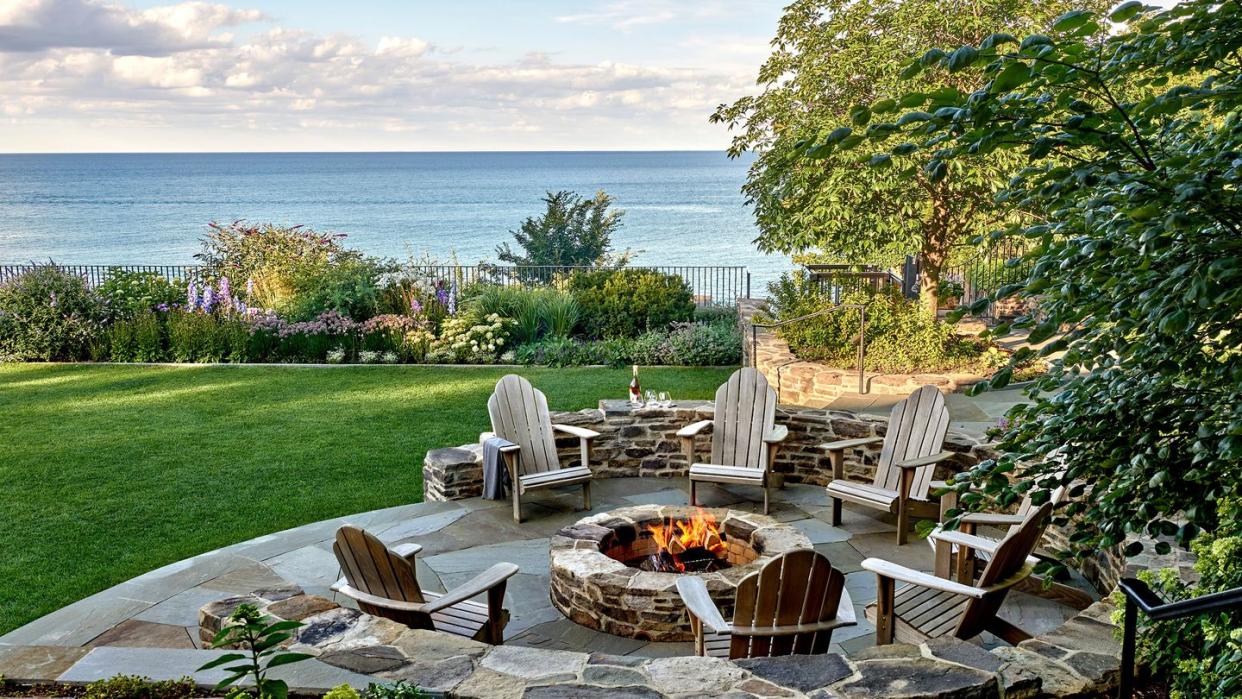Is It Safe To Burn a Backyard Fire Pit Once a Week?

"Hearst Magazines and Yahoo may earn commission or revenue on some items through these links."
Whether it's in your backyard or at a campsite, gathering around a crackling fire pit with s'mores is a quintessential way to enjoy summer nights. Stoking the flames in your fire pit is also a way to extend the outdoor patio season into the cooler shoulder months of spring and fall. But is burning a fire pit every week safe when it comes to your lungs? And how about the environment?
Health and environmental experts warn against this type of regular use of outdoor fire pits because the smoke that comes from burning wood creates something known as fine-particle air pollution. The smoke might make you cough or sting your eyes when a plume of it hits you, but that's not all it's doing: Frequent exposure to wood smoke can also increase your risk of serious conditions like lung cancer and chronic obstructive pulmonary disease (COPD), according to health experts and the American Lung Association.
Ahead, experts weigh in on the health risks associated with frequently gathering around wood-burning fire pits as well as provide safety tips should you spend some time around a campfire.
What Are the Health Risks of Burning a Fire Pit?
Wood smoke is made up of fine particles, including soot and particulate matter 2.5. This means that 20 of these particles are the width of a single human hair, explains the American Lung Association.
While you can't see the tiny particles without a microscope, they get into your eyes and respiratory system, which, in the short term, can cause irritations like burning eyes and a runny nose, according to public health experts at the U.S. Environmental Protection Agency (EPA). Breathing in even small amounts of wood smoke can make you feel drowsy, disoriented, and short of breath, functional nutritionist Patrick Nuzzo, cofounder of the Southwest University of Naprapathic Medicine, says.
The smoke can also have more serious effects. "Wood fires generate smoke, which contributes to air pollution and the fine particles contribute to lung and heart disease," Michael Kleinman, PhD, codirector of the Air Pollution Health Effects Laboratory at the University of California, Irvine, says. People who have respiratory problems such as asthma, COPD, or emphysema are more likely to be at risk from health effects related to fire pit emissions, he adds.
But it's not just your lungs that could be put at risk. Particles and nitrogen oxides in the air we breathe are linked to increased hospital admissions, heart attacks, and heart-related deaths, Kleinman explains, so people who have pre-existing heart disease might also be at elevated risk when it comes to exposure to wood smoke.
If accelerants are used to get the fire started, those can add extra toxic pollutants to the mix, Kleinman says.
While you might not mind the smoke, it could be irritating to a neighbor if the wind is blowing it into their yard. In fact, wood-burning fire pits are not allowed in many communities, Kleinman points out.
Is There a Safe Way to Enjoy a Fire Pit?

The most dangerous instances of outdoor fire pit use include any that burn treated or painted wood or wood products because those are very often toxic, Kleinman says. For example, treated wood can contain arsenic or lead as preservatives and fire retardants.
If you do burn wood for a fire, your safest option is dry, aged wood that's been stored for at least six months in a dry, covered area, according to the American Lung Association. Also, don't burn a wood fire on a bad air quality day when the air pollution is already elevated.
The EPA also recommends using a moisture meter to check firewood. You want the moisture content to be at about 20 percent so it slows the burn.
Fire pits should be used only in well-ventilated spaces because they can also generate carbon monoxide, which is highly toxic, Kleinman says.
Be careful not to start a fire outside your pit too: "Embers from live flames can stay airborne for long periods and can be a fire hazard for nearby vegetation or structures," Kleinman says.
Are Gas Fire Pits Safer Than Wood-Burning Fire Pits?

Fire pits that are gas fired (meaning they use compressed natural gas or propane for fuel) tend to be safer alternatives to wood-burning fire pits as long as the unit is operating properly, Kleinman says. Still, even when they're working correctly, they can emit sulfur oxides and nitrogen oxides, which are toxic air pollutants, he says.
If you notice the flame is yellow, that can mean that the air-to-fuel ratio is too low and the emissions can contain soot and other toxic compounds.
The takeaway: Gathering around a campfire a couple of times this summer and taking the necessary precautions when it comes to burning wood fires shouldn't pose much of a problem. But burning a fire every weekend in your fire pit will increase your exposure to particle pollution, which is something you're already unwillingly exposed to when the air is hazy from vehicle exhaust or a nearby wildfire.
Follow House Beautiful on Instagram and TikTok.
You Might Also Like
